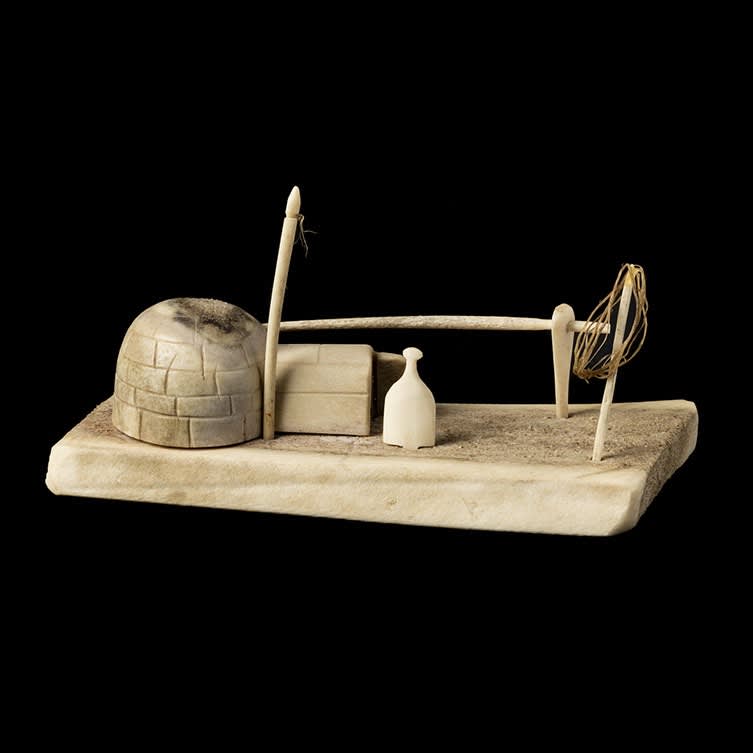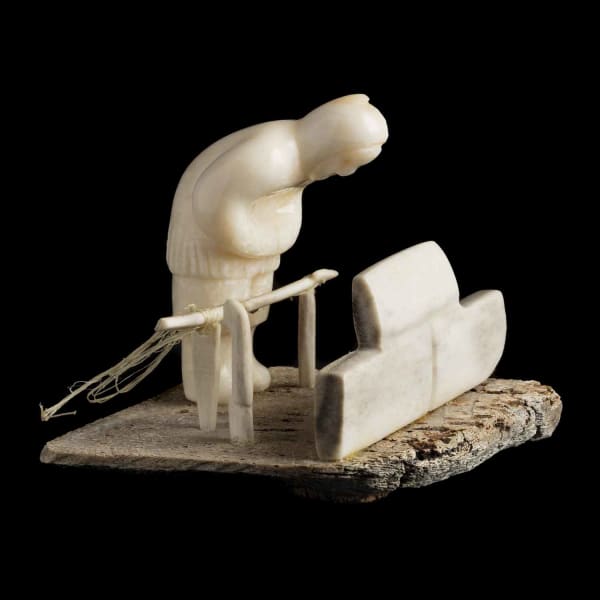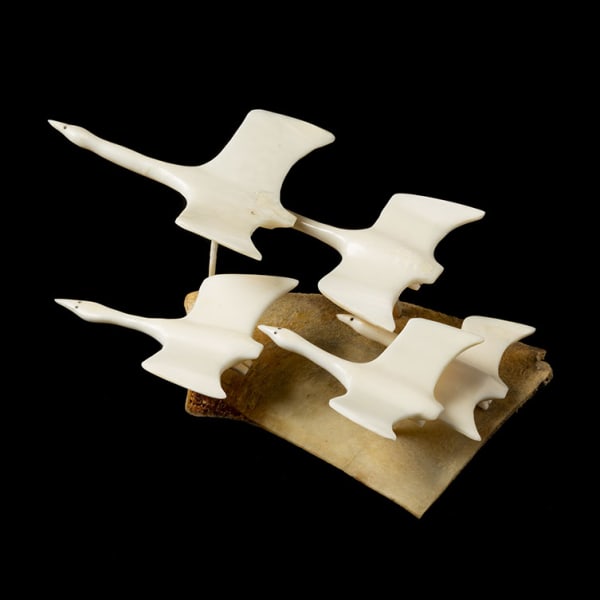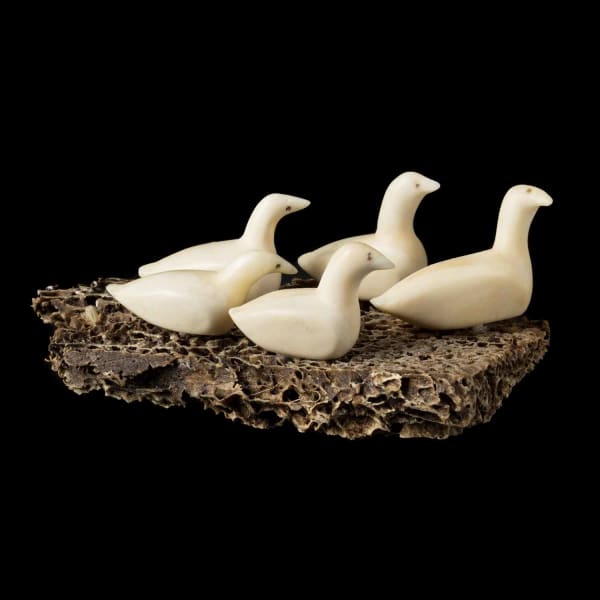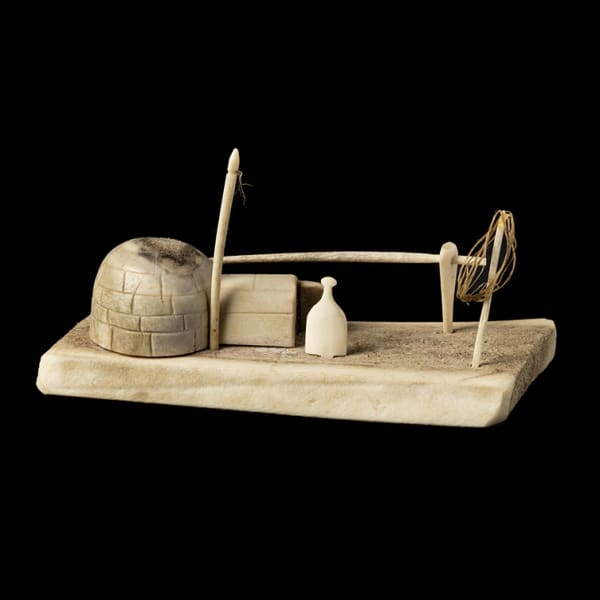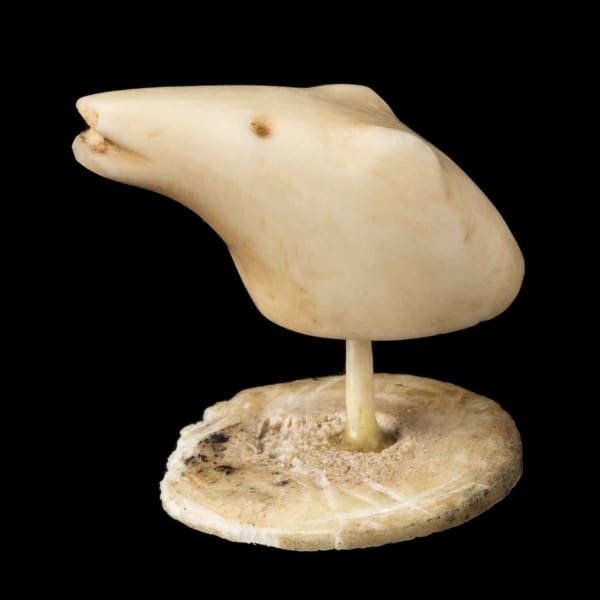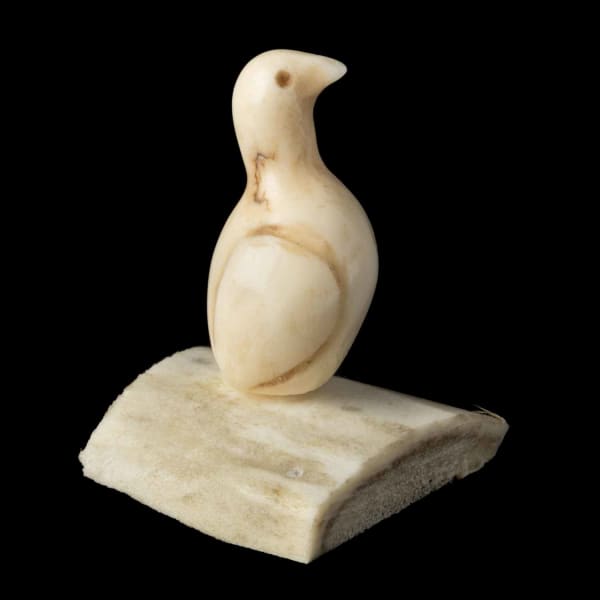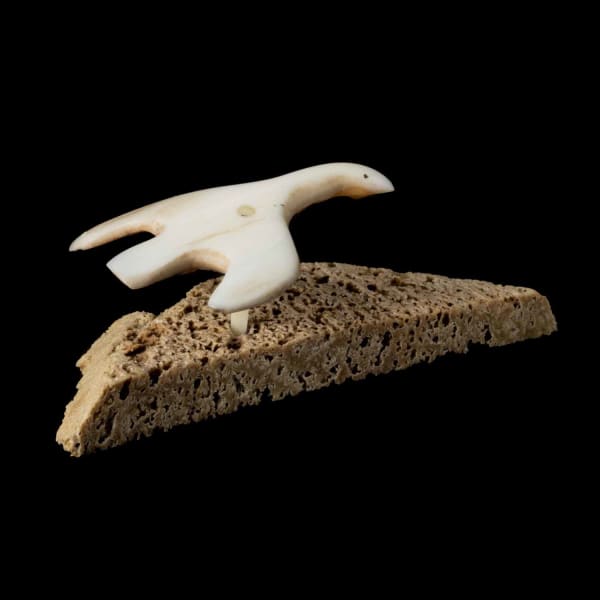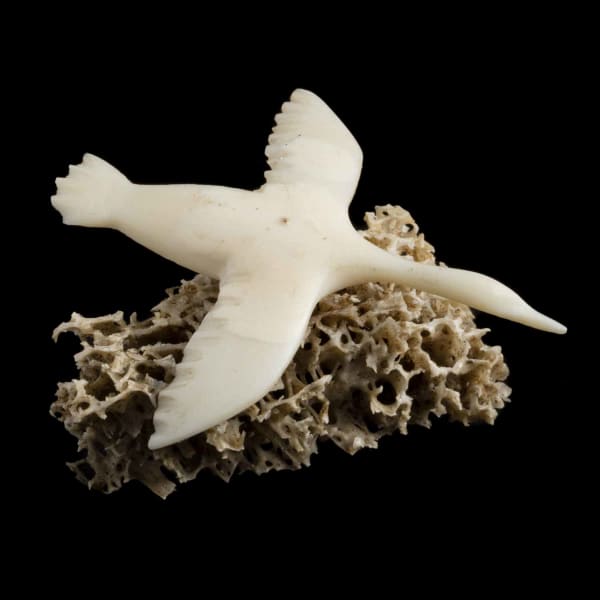Little Worlds: The Norman Hallendy Collection of Ivory Miniatures
It is with great pleasure that Galerie Elca London (1444 Sherbrooke Street West, #100, Montreal), in collaboration with First Arts, presents the Hallendy Collection of miniature ivories.
The ethnogeographer Norman Hallendy assembled this important collection mostly in the years 1968-1971, a time of extraordinary creativity in the small communities of Naujaat (Repulse Bay) and Kugaaruk (Pelly Bay).
Carved mostly in ivory but incorporating other natural materials as well, these beautiful miniatures exude both a preciousness and a timeless quality that bring to mind the lovely small works made during the Historic Period of Inuit art in the 19th and early 20th centuries. While some of these carvings are firmly attributed to renowned artists such as Mark Tungilik (1913-1986) and Fabien Oogaaq (1923-1992), and others have possible attributions to them, all of these beautiful works exhibit the fine workmanship, intimate knowledge of subject matter and materials, careful attention to detail, and homespun charm that make this “school” of Inuit art so appealing.
Enjoy!
— Ingo Hessel
Works included in this exhibition can be viewed online and in person at Galerie Elca London by appointment. To book an appointment, please contact info@firstarts.ca
First Arts is proud to present this remarkable collection of miniature carvings assembled by ethnogeographer Norman Hallendy, mostly during a short period from 1968 to 1971, when he travelled to the tiny communities of Naujaat (Repulse Bay) and Kugaaruk (Pelly Bay). This collecting took place during a brief but extraordinary time that witnessed a burst of creative energy in these two communities.
The Hallendy collection is an important assemblage of beautiful miniature carvings – mostly ivory but incorporating other materials as well – that reflects a unique aspect of Inuit intellectual culture and visual expression. It opens a window into a special time and place in the history of Inuit art. The collection offers the lucky viewer intimate glimpses into beautiful, self-contained “little worlds.”
Many years ago while I was passing through Kugaaruk, an old hunter who needed a few dollars to buy some tobacco offered me a miniature harpoon head. It was no bigger than the length of my little finger. It was beautifully carved, and included the lashings to fix it to a harpoon shaft. I asked if this was meant to be a toy. The
old man assured me that it was not. He went on to explain that it was meant to be sewn into one’s parka to ensure good hunting.
This encounter would guide me throughout the years to collect Inuit carvings primarily from an “ethnographic” rather than an aesthetic perspective. By that I mean that I sought out pieces that conformed to the stories, experiences and beliefs of the elders. It almost goes without saying, of course, that the ivories are also exceedingly beautiful.
— Norman Hallendy
Central Arctic: Miniature Carving
In the late nineteenth century, the northwest coast of Hudson Bay became a key centre of miniature ivory and stone carving. Roes Welcome Sound, a narrow strait between the Keewatin mainland and Southampton Island, was a particularly rich whaling ground, and Inuit from the region (especially Repulse Bay) worked for and traded with whalers and explorers. In the twentieth century, the Inuit of Chesterfield Inlet and Repulse Bay (now called Naujaat) in the Keewatin, and their neighbours from Pelly Bay (now called Kugaaruk) – in the Kitikmeot Region, 300 kilometres/185 miles northwest overland from Naujaat) – were encouraged by Roman Catholic missionaries to produce ivory miniature models and figures. Ivory miniatures (as well as modest works in stone and antler with a similar sensibility) are still carved in the region, harking back to the unassuming models and “trinkets” traded during the Historic Period (19th and early 20th centuries).
Work on a very small scale is very appealing, as it appears to be carved with greater finesse than other sculpture. While a miniature figure does require more dexterity and careful cutting, the details are not usually more precise, but are simply smaller. In fact, details are often simplified, resulting in a streamlining of form or sometimes a certain “precious crudeness.” Ivory as a material lends itself to miniature carving more readily than stone does, and has an intrinsically precious quality that enhances the overall effect of works on a small scale. Naujaat and Kugaaruk miniatures invite close inspection, literally drawing us into their “little worlds.”
Naujaat (Repulse Bay)
Although Naujaat, situated at the base of the Melville Peninsula, falls within the Keewatin Region politically, culturally it is related to the Iglulingmiut groups to the north. Artistically, its roots are very much in the late Historic Period, influenced by decades of contact and trade with whalers. Already in the 1940s and into the 1950s, due to significant encouragement from missionaries and sympathetic Hudson’s Bay Company post managers, Naujaat artists produced small animal and human figures as well as constructing ivory, stone, whale bone, and antler tableaux. The pioneering Inuit scholar George Swinton was right to suggest that the poses found in the small-scale carvings, which actually add to their toy-like and homespun charm, do not lend themselves to magnification. Naujaat subject matter focuses on camp and hunting scenes, with considerable animal-human interaction but few overt references to shamanism or traditional spiritual beliefs. One well-known artist, Mark Tungilik, learned to carve ivory as a young man in nearby Kugaaruk, creating both traditional and Christian imagery as early as the 1930s. He later moved to Naujaat and became famous for his quirky “micro-miniature” ivory depictions of people, animals and spirits.
Kugaaruk (Pelly Bay)
Kugaaruk, a small village west of the Melville Peninsula, was almost completely insulated from the outside world until 1955 when its DEW Line site was built; even then, ice jams at the mouth of the bay made the community inaccessible by sea. An airstrip was constructed only in 1968, and many Inuit families did not settle in the community permanently until the early 1970s. An Oblate missionary, Father Franz Van de Velde, the only white resident in the community between 1945 and 1961, strongly encouraged the production and marketing of ivory miniatures and scenes. Kugaaruk artists persisted in carving mostly miniatures well into the 1970s, largely because the community was so inaccessible; small ivories were easier and cheaper to ship out on occasional flights.
(Text adapted from Ingo Hessel, Inuit Art: An Introduction, 1998, pp. 106-109)
-
 UNIDENTIFIED ARTIST, KUGAARUK (PELLY BAY)Hunter with Sled Dog, 1970ivory, whalebone, and antler, 3.25 x 1.25 x 3.25 in (8.3 x 3.2 x 8.3 cm)
UNIDENTIFIED ARTIST, KUGAARUK (PELLY BAY)Hunter with Sled Dog, 1970ivory, whalebone, and antler, 3.25 x 1.25 x 3.25 in (8.3 x 3.2 x 8.3 cm)
unsigned. -
 MARGUERITE ANERNERK KATOKRA (1934-), NAUJAAT (REPULSE BAY)Two Flying Birds, Two Narwhals and a Beluga, 1970ivory, green stone, wood2 3/4 x 2 1/2 x 3 1/4 in
MARGUERITE ANERNERK KATOKRA (1934-), NAUJAAT (REPULSE BAY)Two Flying Birds, Two Narwhals and a Beluga, 1970ivory, green stone, wood2 3/4 x 2 1/2 x 3 1/4 in
7 x 6.3 x 8.3 cm -
 UNIDENTIFIED ARTIST, KUGAARUK (PELLY BAY)Hunter Waiting at a Seal Hole, 1970ivory, antler, whalebone, sinew2 1/2 x 2 1/2 x 2 1/2 in
UNIDENTIFIED ARTIST, KUGAARUK (PELLY BAY)Hunter Waiting at a Seal Hole, 1970ivory, antler, whalebone, sinew2 1/2 x 2 1/2 x 2 1/2 in
6.3 x 6.3 x 6.3 cm -
 UNIDENTIFIED ARTIST, KUGAARUK (PELLY BAY)Polar Bear Stalking Two Seals, 1969ivory, whalebone1 1/4 x 2 3/4 x 5 1/4 in
UNIDENTIFIED ARTIST, KUGAARUK (PELLY BAY)Polar Bear Stalking Two Seals, 1969ivory, whalebone1 1/4 x 2 3/4 x 5 1/4 in
3.2 x 7 x 13.3 cm -
 UNIDENTIFIED ARTIST, KUGAARUK (PELLY BAY)Hunter Crawling Towards a Seal, 1970ivory, antler, whalebone1 1/4 x 2 1/2 x 3 3/4 in
UNIDENTIFIED ARTIST, KUGAARUK (PELLY BAY)Hunter Crawling Towards a Seal, 1970ivory, antler, whalebone1 1/4 x 2 1/2 x 3 3/4 in
3.2 x 6.3 x 9.5 cm -
 FABIEN OOGAAQ (1923-1992), KUGAARUK (PELLY BAY)Standing Man, 1970ivory2 3/4 x 1 1/4 x 3/4 in
FABIEN OOGAAQ (1923-1992), KUGAARUK (PELLY BAY)Standing Man, 1970ivory2 3/4 x 1 1/4 x 3/4 in
7 x 3.2 x 1.9 cm -
 UNIDENTIFIED ARTIST, NAUJAAT (REPULSE BAY)Flying Bird, 1970 (circa)ivory, whalebone2 1/2 x 3 1/4 x 1 1/2 in
UNIDENTIFIED ARTIST, NAUJAAT (REPULSE BAY)Flying Bird, 1970 (circa)ivory, whalebone2 1/2 x 3 1/4 x 1 1/2 in
6.3 x 8.3 x 3.8 cm -
 UNIDENTIFIED ARTIST, Probably KUGAARUK (PELLY BAY)Hunter with a Spear, 1969caribou bone, whalebone4 x 2 x 2 3/4 in
UNIDENTIFIED ARTIST, Probably KUGAARUK (PELLY BAY)Hunter with a Spear, 1969caribou bone, whalebone4 x 2 x 2 3/4 in
10.2 x 5.1 x 7 cm -
 Attr: FABIEN OOGAAQ (1923-1992), KUGAARUK (PELLY BAY)Three Birds, 1968ivory and whalebone3 1/2 x 2 1/2 x 5 3/4 in
Attr: FABIEN OOGAAQ (1923-1992), KUGAARUK (PELLY BAY)Three Birds, 1968ivory and whalebone3 1/2 x 2 1/2 x 5 3/4 in
8.9 x 6.3 x 14.6 cm -
 FABIEN OOGAAQ (1923-1992), KUGAARUK (PELLY BAY)Hunter with a Spear, 1970ivory, whalebone3 3/4 x 2 x 2 1/2 in
FABIEN OOGAAQ (1923-1992), KUGAARUK (PELLY BAY)Hunter with a Spear, 1970ivory, whalebone3 3/4 x 2 x 2 1/2 in
9.5 x 5.1 x 6.3 cm -
 UNIDENTIFIED ARTIST, KUGAARUK (PELLY BAY)Five Flying Swans, 1969ivory, whalebone1 1/4 x 1 3/4 x 6 in
UNIDENTIFIED ARTIST, KUGAARUK (PELLY BAY)Five Flying Swans, 1969ivory, whalebone1 1/4 x 1 3/4 x 6 in
3.2 x 4.4 x 15.2 cm -
 UNIDENTIFIED ARTIST, KUGAARUK (PELLY BAY)Four Swimming Birds, 1969ivory, whalebone1 1/4 x 1 3/4 x 6 in
UNIDENTIFIED ARTIST, KUGAARUK (PELLY BAY)Four Swimming Birds, 1969ivory, whalebone1 1/4 x 1 3/4 x 6 in
3.2 x 4.4 x 15.2 cm -
 UNIDENTIFIED ARTIST, KUGAARUK (PELLY BAY)Walrus and Seal, 1969ivory, whalebone1 1/4 x 2 1/4 x 3 1/4 in
UNIDENTIFIED ARTIST, KUGAARUK (PELLY BAY)Walrus and Seal, 1969ivory, whalebone1 1/4 x 2 1/4 x 3 1/4 in
3.2 x 5.7 x 8.3 cm -
 UNIDENTIFIED ARTIST, KUGAARUK (PELLY BAY)Birds, 1971ivory, whalebone1 1/2 x 1 x 4 in
UNIDENTIFIED ARTIST, KUGAARUK (PELLY BAY)Birds, 1971ivory, whalebone1 1/2 x 1 x 4 in
3.8 x 2.5 x 10.2 cm -
 UNIDENTIFIED ARTIST, KUGAARUK (PELLY BAY)Mother Seal and Four Pups, 1969ivory, whalebone1 x 3 x 4 1/4 in
UNIDENTIFIED ARTIST, KUGAARUK (PELLY BAY)Mother Seal and Four Pups, 1969ivory, whalebone1 x 3 x 4 1/4 in
2.5 x 7.6 x 10.8 cm -
 UNIDENTIFIED ARTIST, Probably KUGAARUK (PELLY BAY)Two Basking Seals, 1968ivory, whalebone1/2 x 3 1/2 x 1 in
UNIDENTIFIED ARTIST, Probably KUGAARUK (PELLY BAY)Two Basking Seals, 1968ivory, whalebone1/2 x 3 1/2 x 1 in
1.3 x 8.9 x 2.5 cm -
 UNIDENTIFIED ARTIST, KUGAARUK (PELLY BAY)Swan with Head Lowered, 1971ivory, whalebone1 1/4 x 2 1/4 x 3 in
UNIDENTIFIED ARTIST, KUGAARUK (PELLY BAY)Swan with Head Lowered, 1971ivory, whalebone1 1/4 x 2 1/4 x 3 in
3.2 x 5.7 x 7.6 cm -
 UNIDENTIFIED ARTIST, KINNGAIT (CAPE DORSET)Standing Woman, 1978sperm whale ivory, 3 x 1.25 x 1.5 in (7.6 x 3.2 x 3.8 cm)
UNIDENTIFIED ARTIST, KINNGAIT (CAPE DORSET)Standing Woman, 1978sperm whale ivory, 3 x 1.25 x 1.5 in (7.6 x 3.2 x 3.8 cm)
unsigned. -
 UNIDENTIFIED ARTIST, KINNGAIT (CAPE DORSET)Walking Polar Bear, 1982caribou antler1 1/2 x 1 1/4 x 3 1/2 in
UNIDENTIFIED ARTIST, KINNGAIT (CAPE DORSET)Walking Polar Bear, 1982caribou antler1 1/2 x 1 1/4 x 3 1/2 in
3.8 x 3.2 x 8.9 cm -
 Attributed to MARK TUNGILIK (1913-1986), NAUJAAT (REPULSE BAY)Flying Bird, 1969ivory, whalebone3/4 x 1 1/2 x 1 3/4 in
Attributed to MARK TUNGILIK (1913-1986), NAUJAAT (REPULSE BAY)Flying Bird, 1969ivory, whalebone3/4 x 1 1/2 x 1 3/4 in
1.9 x 3.8 x 4.4 cm -
 UNIDENTIFIED ARTIST, KUGAARUK (PELLY BAY)Flying Birdivory, bone1 x 1 x 2 1/4 in
UNIDENTIFIED ARTIST, KUGAARUK (PELLY BAY)Flying Birdivory, bone1 x 1 x 2 1/4 in
2.5 x 2.5 x 5.7 cm -
 UNIDENTIFIED ARTIST, KUGAARUK (PELLY BAY) areaSwimming Bird, 1968 (before)ivory, whalebone3/4 x 1 1/4 x 2 3/4 in
UNIDENTIFIED ARTIST, KUGAARUK (PELLY BAY) areaSwimming Bird, 1968 (before)ivory, whalebone3/4 x 1 1/4 x 2 3/4 in
1.9 x 3.2 x 7 cm -
 UNIDENTIFIED ARTIST, KANNGIQTUGAAPIK (CLYDE RIVER)Narwhal, 1969bone, ivory1 x 1 1/4 x 3 1/2 in
UNIDENTIFIED ARTIST, KANNGIQTUGAAPIK (CLYDE RIVER)Narwhal, 1969bone, ivory1 x 1 1/4 x 3 1/2 in
2.5 x 3.2 x 8.9 cm -
 LEONIE ANINGNAQ OOGAAQ (1928-1975), KUGAARUK (PELLY BAY)Swimming Bird, 1970ivory, whalebone3/4 x 1 x 2 1/2 in
LEONIE ANINGNAQ OOGAAQ (1928-1975), KUGAARUK (PELLY BAY)Swimming Bird, 1970ivory, whalebone3/4 x 1 x 2 1/2 in
1.9 x 2.5 x 6.3 cm -
 UNIDENTIFIED ARTIST, KUGAARUK (PELLY BAY)Four Birds, 1971ivory, antler1 1/4 x 3 3/4 x 1 1/2 in
UNIDENTIFIED ARTIST, KUGAARUK (PELLY BAY)Four Birds, 1971ivory, antler1 1/4 x 3 3/4 x 1 1/2 in
3.2 x 9.5 x 3.8 cm -
 Attr: FABIEN OOGAAQ (1923-1992), KUGAARUK (PELLY BAY)Flying Bird, 1970ivory, bone1 3/4 x 2 x 2 3/4 in
Attr: FABIEN OOGAAQ (1923-1992), KUGAARUK (PELLY BAY)Flying Bird, 1970ivory, bone1 3/4 x 2 x 2 3/4 in
4.4 x 5.1 x 7 cm -
 UNIDENTIFIED ARTIST, KUGAARUK (PELLY BAY)Standing Bird, 1971ivory, whalebone1 3/4 x 2 x 1 1/4 in
UNIDENTIFIED ARTIST, KUGAARUK (PELLY BAY)Standing Bird, 1971ivory, whalebone1 3/4 x 2 x 1 1/4 in
4.4 x 5.1 x 3.2 cm -
 UNIDENTIFIED ARTIST, KUGAARUK (PELLY BAY)Five Birds, 1971ivory, whalebone1 1/4 x 2 x 3 3/4 in
UNIDENTIFIED ARTIST, KUGAARUK (PELLY BAY)Five Birds, 1971ivory, whalebone1 1/4 x 2 x 3 3/4 in
3.2 x 5.1 x 9.5 cm -
 UNIDENTIFIED ARTIST, KUGAARUK (PELLY BAY)Igloo Camp Scene (Igloo, Drying Rack, Snow Shovel, and Harpoons), 1967caribou antler, ivory, bone, and sinew, 1.5 x 1.75 x 4.25 in (3.8 x 4.4 x 10.8 cm)
UNIDENTIFIED ARTIST, KUGAARUK (PELLY BAY)Igloo Camp Scene (Igloo, Drying Rack, Snow Shovel, and Harpoons), 1967caribou antler, ivory, bone, and sinew, 1.5 x 1.75 x 4.25 in (3.8 x 4.4 x 10.8 cm) -
 UNIDENTIFIED ARTIST, KUGAARUK (PELLY BAY)Kayaker, 1968caribou antler, ivory, sinew1 3/4 x 2 1/2 x 6 1/2 in
UNIDENTIFIED ARTIST, KUGAARUK (PELLY BAY)Kayaker, 1968caribou antler, ivory, sinew1 3/4 x 2 1/2 x 6 1/2 in
4.4 x 6.3 x 16.5 cm -
 UNIDENTIFIED ARTIST, KUGAARUK (PELLY BAY)Kayker, 1970ivory2 x 5 x 9 in
UNIDENTIFIED ARTIST, KUGAARUK (PELLY BAY)Kayker, 1970ivory2 x 5 x 9 in
5.1 x 12.7 x 22.9 cm -
 UNIDENTIFIED ARTIST, KUGAARUK (PELLY BAY)Lemming, 1970ivory1 x 3/4 x 1 1/2 in
UNIDENTIFIED ARTIST, KUGAARUK (PELLY BAY)Lemming, 1970ivory1 x 3/4 x 1 1/2 in
2.5 x 1.9 x 3.8 cm -
 UNIDENTIFIED ARTIST, KUGAARUK (PELLY BAY)Bear’s Head, 1970ivory, caribou antler1 x 3/4 x 1 in
UNIDENTIFIED ARTIST, KUGAARUK (PELLY BAY)Bear’s Head, 1970ivory, caribou antler1 x 3/4 x 1 in
2.5 x 1.9 x 2.5 cm -
 UNIDENTIFIED ARTIST, KUGAARUK (PELLY BAY)Bird, 1969ivory, walrus molar1 x 1/2 x 1 3/4 in
UNIDENTIFIED ARTIST, KUGAARUK (PELLY BAY)Bird, 1969ivory, walrus molar1 x 1/2 x 1 3/4 in
2.5 x 1.3 x 4.4 cm -
 UNIDENTIFIED ARTIST, KUGAARUK (PELLY BAY)Bird, 1969ivory, whalebone1 x 1/2 x 1 1/2 in
UNIDENTIFIED ARTIST, KUGAARUK (PELLY BAY)Bird, 1969ivory, whalebone1 x 1/2 x 1 1/2 in
2.5 x 1.3 x 3.8 cm -
 UNIDENTIFIED ARTIST, PLACE OF ORIGIN UNKNOWNBear Effigy (Ritually killed Polar Bear), date unknownwhalebone, bone1 x 1 x 1/2 in
UNIDENTIFIED ARTIST, PLACE OF ORIGIN UNKNOWNBear Effigy (Ritually killed Polar Bear), date unknownwhalebone, bone1 x 1 x 1/2 in
2.5 x 2.5 x 1.3 cm -
 UNIDENTIFIED ARTIST, KUGAARUK (PELLY BAY)Rabbit, 1971ivory, whalebone1 1/2 x 1 x 1 1/2 in
UNIDENTIFIED ARTIST, KUGAARUK (PELLY BAY)Rabbit, 1971ivory, whalebone1 1/2 x 1 x 1 1/2 in
3.8 x 2.5 x 3.8 cm -
 UNIDENTIFIED ARTIST, KUGAARUK (PELLY BAY)Bird, 1968ivory, antler1 1/2 x 1 x 1 in
UNIDENTIFIED ARTIST, KUGAARUK (PELLY BAY)Bird, 1968ivory, antler1 1/2 x 1 x 1 in
3.8 x 2.5 x 2.5 cm -
 UNIDENTIFIED ARTIST, KUGAARUK (PELLY BAY)Bird, 1971ivory, whalebone1 x 3/4 x 1 in
UNIDENTIFIED ARTIST, KUGAARUK (PELLY BAY)Bird, 1971ivory, whalebone1 x 3/4 x 1 in
2.5 x 1.9 x 2.5 cm -
 UNIDENTIFIED ARTIST, KUGAARUK (PELLY BAY)Flying Bird, 1969ivory, whalebone3/4 x 1 3/4 x 3/4 in
UNIDENTIFIED ARTIST, KUGAARUK (PELLY BAY)Flying Bird, 1969ivory, whalebone3/4 x 1 3/4 x 3/4 in
1.9 x 4.4 x 1.9 cm -
 UNIDENTIFIED ARTIST, Probably NAUJAAT (REPULSE BAY)Bird and Narwhal, 1970ivory, green stone1 x 2 1/4 x 2 in
UNIDENTIFIED ARTIST, Probably NAUJAAT (REPULSE BAY)Bird and Narwhal, 1970ivory, green stone1 x 2 1/4 x 2 in
2.5 x 5.7 x 5.1 cm -
 UNIDENTIFIED ARTIST, POSSIBLY ARCTIC BAYDrum Dancer, 1973bone and ivory, 2 3/4 x 1 1/2 x 2 1/2 in (7 x 3.8 x 6.3 cm)
UNIDENTIFIED ARTIST, POSSIBLY ARCTIC BAYDrum Dancer, 1973bone and ivory, 2 3/4 x 1 1/2 x 2 1/2 in (7 x 3.8 x 6.3 cm) -
 UNIDENTIFIED ARTIST, Probably NAUJAAT (REPULSE BAY)Three Narwhals Swimming, 1972ivory, green stone2 x 3 1/4 x 3 1/4 in
UNIDENTIFIED ARTIST, Probably NAUJAAT (REPULSE BAY)Three Narwhals Swimming, 1972ivory, green stone2 x 3 1/4 x 3 1/4 in
5.1 x 8.3 x 8.3 cm -
 UNIDENTIFIED ARTIST, NAUJAAT (REPULSE BAY)Flying Bird, 1970 (circa)ivory, whalebone3/4 x 1 3/4 x 3/4 in
UNIDENTIFIED ARTIST, NAUJAAT (REPULSE BAY)Flying Bird, 1970 (circa)ivory, whalebone3/4 x 1 3/4 x 3/4 in
1.9 x 4.4 x 1.9 cm -
 UNIDENTIFIED ARTIST, KUGAARUK (PELLY BAY)Mother with a Child in her Amaut, Walking, 1970ivory, lichen-spotted bone1 1/4 x 3/4 x 3 3/4 in
UNIDENTIFIED ARTIST, KUGAARUK (PELLY BAY)Mother with a Child in her Amaut, Walking, 1970ivory, lichen-spotted bone1 1/4 x 3/4 x 3 3/4 in
3.2 x 1.9 x 9.5 cm -
 UNIDENTIFIED ARTIST, NAUJAAT (REPULSE BAY)Flying Bird, 1970 (circa)ivory, whalebone1 x 1 1/2 x 2 in
UNIDENTIFIED ARTIST, NAUJAAT (REPULSE BAY)Flying Bird, 1970 (circa)ivory, whalebone1 x 1 1/2 x 2 in
2.5 x 3.8 x 5.1 cm -
 UNIDENTIFIED ARTIST, NAUJAAT (REPULSE BAY)Swimming Bird, 1970 (circa)ivory1/2 x 1 1/4 x 1/2 in
UNIDENTIFIED ARTIST, NAUJAAT (REPULSE BAY)Swimming Bird, 1970 (circa)ivory1/2 x 1 1/4 x 1/2 in
1.3 x 3.2 x 1.3 cm -
 UNIDENTIFIED ARTIST, KUGAARUK (PELLY BAY)Polar Bear, 1968ivory1 1/4 x 3/4 x 2 1/2 in
UNIDENTIFIED ARTIST, KUGAARUK (PELLY BAY)Polar Bear, 1968ivory1 1/4 x 3/4 x 2 1/2 in
3.2 x 1.9 x 6.3 cm -
 UNIDENTIFIED ARTIST, KUGAARUK (PELLY BAY)Polar Bear, 1968antler3/4 x 3/4 x 2 in
UNIDENTIFIED ARTIST, KUGAARUK (PELLY BAY)Polar Bear, 1968antler3/4 x 3/4 x 2 in
1.9 x 1.9 x 5.1 cm -
 Possibly: MARK TUNGILIK (1913-1986), NAUJAAT (REPULSE BAY)Five Snow Geese Swimming, 1967each approx.: 6/50 8/50 in
Possibly: MARK TUNGILIK (1913-1986), NAUJAAT (REPULSE BAY)Five Snow Geese Swimming, 1967each approx.: 6/50 8/50 in
0.3 - 0.4 cm

